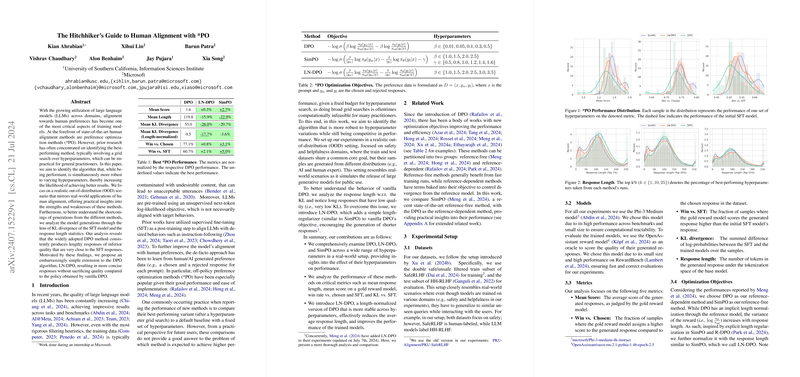A Comprehensive Analysis of Preference Optimization Methods in Human Alignment for LLMs
The paper "The Hitchhiker's Guide to Human Alignment with *PO" addresses the critical task of aligning LLMs to human preferences, leveraging preference optimization methods (*PO). This work is particularly focused on identifying preference optimization algorithms that, while delivering robust performance, demonstrate resilience to varying hyperparameters. The research is motivated by the practical constraints faced by general practitioners, where extensive hyperparameter sweeps are computationally prohibitive.
Abstract and Introduction
The primary objective of the paper is to determine which *PO algorithm performs robustly across different hyperparameter configurations in an out-of-distribution (OOD) scenario. Comparable to real-world applications, this approach simulates the release of large generative models for public use. The authors critically analyze methods like Direct Preference Optimization (DPO) and propose an extension named Length-Normalized DPO (LN-DPO) to tackle the generation of excessively lengthy and low-quality responses by vanilla DPO. The LN-DPO method introduces a length regularizer to the DPO algorithm, producing more concise responses while maintaining quality.
Analysis of Existing Methods
In the field of preference optimization, DPO has gained traction for its simplicity and effectiveness. However, its lack of built-in mechanisms to control response length often results in verbose and low-quality outputs. The paper dissects this issue through the lens of KL divergence and response length statistics, highlighting that DPO's responses are qualitatively similar to those from supervised fine-tuning (SFT), yet noticeably longer.
The LN-DPO Proposal
Motivated by the insights from DPO's shortcomings, the authors introduce LN-DPO. This variant integrates a length-normalized adaptation into DPO's objective function, encouraging the generation of shorter responses. The empirical results suggest that LN-DPO not only achieves similar or improved performance compared to traditional DPO but also generates more concise outputs. This advancement is significant in practical applications where both response quality and brevity are essential.
Experimental Setup
The experiments are conducted using the Phi-3 Medium model due to its balance of high performance and computational feasibility. Training and evaluation datasets are chosen to mirror realistic OOD scenarios, with the training set focused on safety-labeled data and the test set derived from helpfulness-focused prompts. Evaluation metrics include mean response length, mean score from a reward model, and win rates against chosen responses and SFT-generated responses. The comprehensive nature of these metrics ensures a holistic evaluation of the proposed algorithms' performance.
Comparative Analysis and Results
The empirical analysis includes:
- Best Performance Comparison: Evaluating the peak performance of DPO, LN-DPO, and SimPO methods, LN-DPO and SimPO consistently outperform DPO across nearly all metrics.
- Hyperparameter Sensitivity: By analyzing the performance of the models over a grid search of hyperparameters, the paper finds that LN-DPO and SimPO display greater resilience to hyperparameter variations compared to DPO. This robustness is crucial for practical deployment where exhaustive hyperparameter tuning is impractical.
- Head-to-Head Performance: To dissect the efficacy of each method, head-to-head comparisons are made between the models' responses to individual prompts. SimPO emerges as the top performer, followed closely by LN-DPO, both demonstrating their superior adaptability and performance consistency.
- Response Length and KL Divergence: LN-DPO effectively reduces the mean response length, addressing the verbosity issue observed in DPO. In terms of KL divergence, both LN-DPO and SimPO show improved divergence scores compared to DPO, indicating better alignment with the reference policy.
Hyperparameter Tuning Insights
The research provides practical insights into hyperparameter tuning for each model:
- For DPO, lower values of (e.g., 0.05) yield better performance but with higher variance.
- LN-DPO shows reliable performance across a moderate range of values (1.0 to 2.0), offering a good balance between stability and performance.
- SimPO's performance peaks with values between 1.0 and 1.5 and around 1.2.
Conclusion
The authors conclude that SimPO, due to its robust performance and lesser computational demand, stands out as the preferred method for general practitioners. However, LN-DPO remains a strong contender, especially in scenarios requiring reference policy regularization to prevent severe deviation from initial checkpoints. The paper’s thorough evaluation and detailed hyperparameter analysis provide valuable insights that can guide future research and practical implementations in aligning LLMs to human preferences.
Future Directions
Future research could explore fine-tuning these methods further, particularly in understanding the conditions under which LN-DPO might be preferable over SimPO. Additionally, integrating these methods into large-scale production environments can validate their pragmatic utility and resilience in diverse application domains.
In conclusion, this work significantly advances the understanding of human preference alignment in LLMs and offers practical solutions for enhancing model reliability and performance in real-world scenarios.
